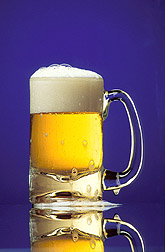This page has been archived and is being provided for reference purposes only. The page is no longer being updated, and therefore, links on the page may be invalid.
|
|
New Barley Bred for Candymakers, Brewmasters—and More
By Marcia WoodDecember 23, 2005
Scrumptious chocolate-malt truffles, perfect for a holiday indulgence, might soon be made with malt from a superb new barley. So might your favorite breakfast cereal or brew, according to plant geneticist Donald E. Obert, a barley and oat breeder with the Agricultural Research Service (ARS).
The novel barley, named "Charles," is the result of more than a decade of testing by Obert and others at the ARS Small Grains and Potato Research Unit in Aberdeen, Idaho.
Colleague Darrell M. Wesenberg, now retired, selected the barley from among thousands of candidate plants in 1994. Over the next 10 years, tests in Idaho, Oregon and Washington showed that this experimental barley, designated as "94AB1274," produced impressive quantities of plump, heavy kernels.
Based on these results, ARS researchers and their University of Idaho co-investigators offered the new barley variety to researchers, plant breeders and seed companies earlier this year. The scientists named the barley "Charles" in honor the late Charles F. Murphy, formerly national program leader for ARS grain crop research.
Now, a major U.S. brewery is leading rigorous tests to determine if the barley meets the exacting standards of the American Malting Barley Association, a feat no U.S.-grown winter malting barley has yet achieved. Results are expected by late 2006.
Winter barleys, planted in Idaho in October and harvested in mid-July, offer several key advantages over spring barleys, planted in May and harvested in August. The fall planting gives the winter varieties a chance to germinate and grow before going into winter dormancy. In spring, the plants are bigger and stronger than spring-planted barleys, which are just beginning to sprout from seed.
Earlier ripening means winter barleys are ready to harvest earlier, often avoiding stress-inducing summer heat that can result in thinner, lighter kernels instead of plump, heavier ones.
What's more, earliness means grain elevators where stores of the previous year's harvest are dwindling can be filled that much sooner.
ARS is the U.S. Department of Agriculture's chief scientific research agency.

